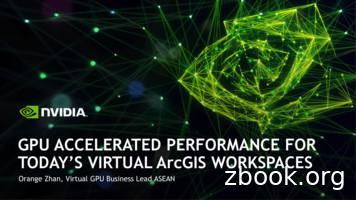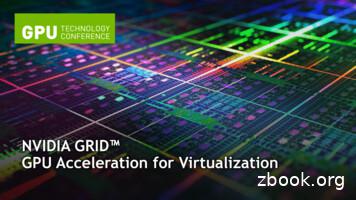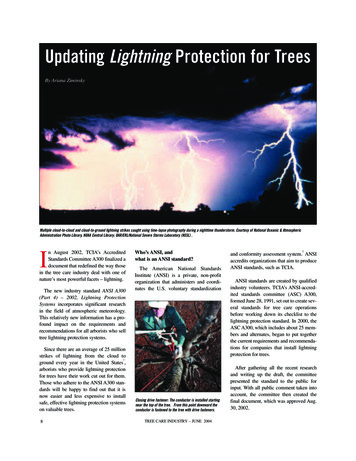NVIDIA Advanced Rendering And GPU Ray Tracing
NVIDIAAdvanced Renderingand GPU Ray TracingSIGGRAPH ASIA 2012SingaporePhillip MillerDirector of Product ManagementNVIDIA Advanced Rendering
Agenda1. What is NVIDIA Advanced Rendering ?2. Progress in NVIDIA Iray3. Progress in NVIDIA OptiX4. GPU Ray Tracing Basics (if there’s time)
NVIDIA Ray Tracing Options CUDA – language and computing platform— The choice for building entirely custom GPU solutions from scratchNVIDIA Advanced Rendering: OptiX – freely licensed middleware for ray tracing developers— Good choice for developers with domain expertise building custom ray tracing solutionswho prefer leaving GPU issues (and ray tracing basics) to NVIDIA Iray & mental ray – commercially licensed rendering products— Good choice for companies wanting a ready-to-integrate solutionwhich is maintained and advanced for them— Iray focuses on the needs of Design markets, while mental ray focuses on Film Production
NVIDIA Commercial Rendering Offerings State-of-the-Art rendering exemplifying what’s possible on the latest GPU technology Completes a vital Feedback Loop to influence NVIDIA (long before products alone & ToolsGPUDesignProfessionalsGPUs Result: best of class solutions for end users, licensees and third party developers
NVIDIA Iray 2013
IrayPhysically Based Rapid Adoption Simplicity:— Photorealism is a goal that bothartists & developers can relate to— Physical model ensuresconsistent algorithms— Results match real worldexperiences with light, distanceand materials— Simplicity ease of use faster production approachable by more usersEasy to Use
NVIDIA Iray for End Users Iray within shipping commercial products:— Autodesk 3ds Max & 3ds Max Design— Dassault Systèmes Catia V6— Bunkspeed SHOT, MOVE, PRO— Cinema 4D (M4D add-on)— SketchUp (Bloom Unit add-on) Now let’s discuss what’s available to these productsto include in their future updates from NVIDIA Iray
Iray 2013just released to commercial licensees For Software Developers wanting to add physically based rendering to theirapplications that is easy to use, highly interactive and scalable Now with render modes, shared materials, cluster management, and cloud renderingScene DatabaseShared MaterialsIray Rendering Modes NetworkNVIDIA irayIrayCoreNVIDIA irayApplicationNVIDIA iray A rich API handshakes with Application manipulation for interactive updates
Iray 2013 – contains Iray 3Major focus for this Iray release: Greatly expand post production possibilities Increase rendering quality for challenging scenarios Improve usability— Reduce noise and artifacts of convergence— Improve data handling to use less memory— Improve interactivity via better balancing of Display GPU— Support new shared material model All while maintaining speed!
New with Iray 3 - Light Path Expressions Similar to traditional “Render Passes” – but on steroids Freely Configurable – can be edited by end users Can be on a light group or per-light basisBeautyNVIDIA 2012SpecularCausticsDirect illumination
Iray Beauty Pass
Diffuse LPE
Specular & Glossy LPE
Light1 and Light2 LPE
Environment Lighting LPE
Light Path Expressions Regular expressions— BSDF components— Emitting light handles & Interacting geometry handles— Considerable flexibility in Post Minimal render time overhead ( 5%)— All buffers render simultaneously— Faster in some cases (e.g. direct illumination only)NVIDIA 2012Object IDMaterial IDZ‐DepthSpecularIrradianceGlossy
New with Iray 3 – Matte Objects Classic workflow more Supports full GI, MBlur, DOFNVIDIA 2012
New with Iray 3 – Matte Objects Classic workflow more Supports full GI, MBlur, DOF Lighting/Shadow “bloom”essential for realismNVIDIA 2012
New with Iray 3 – Matte Objects Back PlateNVIDIA 2012 Chrome Sphere Reference
New with Iray 3 – Matte Objects Stand-In GeometryNVIDIA 2012 Match Materials & Flag Matte Objects
New with Iray 3 – Matte Objects Add synthetic geometry at willNVIDIA 2012 The Iray matte making it possible
New with Iray 3 – Additional Samplers “Caustic”for doing just that “Architectural”a robust path samplerfor highly indirectchallengesIray 3 with new “caustic” samplerNVIDIA 2012
New with Iray 3 – Additional SamplersIray 2.xNVIDIA 2012Iray 3 with new “caustic” sampler
New with Iray 3 – Additional SamplersIray 2.xNVIDIA 2012Iray 3 with new “architectural” sampler
New with Iray 3 – Additional SamplersIray 2.xNVIDIA 2012Iray 3 with new “architectural” sampler
Iray 3 Improved ConvergenceIray 2.x2 minutesIray 3
Iray 3 Improved ConvergenceIray 2.x10 minutesIray 3
Iray 3 Improved ConvergenceIray 2.x30 minutesIray 3
Iray 2013Render Modes Multiple Rendering Modes, providing a quality/speed continuumIray Realtime15 FPS*120 FPSStereoGame Title QualityStrength:Iray PhotorealIray InteractiveMulti‐Pass EffectsRaster AOSoft Shadows, etc.Very High ResolutionsWeakness: Physically Approximate20 FPS0.5 FPS*Accurate ReflectionsSoft ShadowsAccurate ShadowsGlossy ReflectionsMulti‐Bounce Diffuse, etc.10 FPSMinutes*DegradedSimplifiedUncompromised QualityIncreased FlexibilityNo / Little Noise while InteractingPhysically BasedPhysically PlausibleNoisy while Resolving API calls for which mode to use, with what features, what to do on mouse-up, etc.enable custom personalities for behavior and look
Iray 2013 Rendering Modes Iray Photoreal Iray Interactive Interactive but “noisy” Interactive with minimal noise The overall scene resolvesin a couple of minutes Shadows, glossiness and AA resolvein a couple of seconds Can be made faster with lowerquality settings
Iray Photoreal Iray Photorealin a few minutes
Iray Interactivein a few seconds
Iray Shared Materials Physically Based for accuracy (BSDF) Layered for great flexibility Consistent appearanceIray Interactive Processed via the Iray APIIray Photoreal No plans yet for licensing thelanguage processing separately
MDL – Material Description Language NOT a shading language, but a canonical representationwhich renderers can target as they see fitFor material artists: Easy to parse and understand No algorithmic knowledge required Parameters easily exposedFor end users: Assign and edit parameters at will
Iray Cluster Near linear scaling for production rendering Also usable for interactive rendering (on low latency networks) Includes a cluster configuration front end Additional license required
Iray Cloud Scalable rendering power on demand Network protocols to handle private and public clouds Assets are only ever sent once – for minimal upload times Scene edits are handled incrementally – for fast iterations Additional license required
NVIDIA Iray 2013Plug it inNVIDIA 2012
Developers wanting to try Iray 2013 Procedure:1. Register your interest at wnload.html2. NVIDIA reviews application, and grants access to SDK3. Integrate the SDK within your ApplicationResult is full featured, but output constrainedRequires a GPU with at least 2GB of memory4. Once satisfied, obtain a commercial license from NVIDIA
NVDIA OptiX
NVIDIA OptiX ray tracing engineA programmable ray tracing framework enabling the rapiddevelopment of high performance ray tracing applications –from complete renderers to discrete functions(collision, acoustics, ballistics, radiation reflectance, signals, etc.) Use your techniques, methods, and data for your application withsimple programs and a single ray programming model OptiX makes it easy to implement by doing the “heavy lifting” ofray tracing with easy-to-use APIs, for traversal, intersection,and (optionally) shading. OptiX makes it run fast on the GPU, by handling load balancing,parallelism, paging, and optimizing per GPU architecture.
OptiX - similar “in approach” to OpenGL C‐based Shaders/Functions(minimal CUDA exp. reqd.)ApplicationApplication Code & Data StructuresvfgiOpenGLor Direct3DrgmOptiXch Small, Custom Programs Acceleration StructuresBuild & Traversal Optimal GPU parallelismand Performance Memory ManagementGPU Paging
OptiX Across Markets and DisciplinesAs many as 1/3 of OptiX developers don’t “render”, and a verysimple Traversal API makes this even easierOptiX generality includes:No assumptions on technique, shading language, geometry type,or data structureSupports custom ray generation, material shading, objectintersection, scene traversal, ray payloadsProgrammable intersection for custom surface types(procedurals, patches, NURBS, displacement, hair, fur, etc.)
Adobe After Effects CS6 – using OptiXNew 3D compositing with ray traced production renderer Built from scratch, in 1 release cycle 100% OptiX – no x86 code Includes CPU Fallback— Via LLVM in OptiX— Currently unique to Adobe
OptiX for mental ray Ambient Occlusion mental ray 3.11 (released to licensees) pipeline accelerated 20m tri 25– 70X quadcore 20mtri 10 – 20X quadcore 3 minutes2 CPURendered with mental ray 3.9Model courtesy NVIDIA Creative 1.5sec HLBVH build 15sec on Quadro 6000 vs. 20 minutes on CPU
OptiX 2.6 - this past AugustThe OptiX 2.5 feature set with Kepler support using CUDA 4.2 Optimized for NVVM (aka LLVM for CUDA)— Note: CUDA 1.0 to 4.0 used Open64 compiler front end NVVM code generation is very different, but it’s worth it. LLVM is a great leap forward for CUDA, allowing anylanguage to work on the CUDA platform and thus on OptiX Continued to include Paging for out-of core memory situations
OptiX 3 – Shipping December 12, 2012Now based on CUDA 5.0, OptiX 3 includes many highly requested features: CUDA Interop – for sharing CUDA contexts and pointerswith other CUDA programs— See new samples: Collision, Ocean— Includes Multi-GPU support Callable Programs – for Shade Trees, etc. Much faster Acceleration Structure building— SBVH is up to 8X faster (for large assemblies) and compiles 2X faster— BVH refitting on all AS Builders GPU Direct for faster GL interop buffers
OptiX 3 CUDA InteropWater DemoUsing OptiX and PhysX together PhysX CFD water simulation in a 128x128x64 volume Custom OptiX intersection object for water Fresnel dielectric model for water shadingw/ 12 reflection & refraction bounces CUDA Interop exchanges data withoutextra copies– in this case across GPUs Uses FXAA for anti-aliasing(a fantastic new option forinteractive ray tracing)
OptiX 3BVH Refinement “Sbvh” is up to 8X faster “Lbvh” is extremely fast and works on very large datasets BVH Refinement optimizes the quality of a BVH— Smoother scene editing— Smoother animationSlow BuildFast RenderSbvhFast BuildSlow RenderBvhMedianBvhLbvh
OptiX 3 CUDA InteropUsing OptiX and PhysX together NVIDIA PhysX GPU Rigid Bodies CUDA Interop for geometry BVH Refinement: “refit” 1 “refine” 8 OpenGL Interop for TXAA Glass shader with Fresnel reflection— Max ray depth of 12— About 350,000 trianglesFracture Demo
Developers wanting to trying OptiX Procedure:1. Go to NVIDIA Developer Zonehttps://developer.nvidia.com/optix2. Grab the OptiX SDK3. Start coding4. OptiX is completely free to use and deployCPU Fallback is available for license to developers with commercial product
General GPU Ray TracingTopics relating to mostGPU ray tracing applications
GPU Ray Tracing Similarities – Performance Single GPU Ray Tracing Speed— Usually linear to GPU cores and Core Clock – for a given GPU generation— Gains between GPU generations often vary per application / technique Multi-GPU Ray Tracing Speed— Solution dependent, Common in Renderers, OptiX supports by default— Scaling efficiency varies by solution, with slower techniques usuallyscaling better than fast ones Cluster Speed (multi-machine rendering)— Solution dependent, capabilities vary (e.g., Iray supports it, OptiX doesn’t)
Multi-GPU Configurations “SLI” configuration is not needed for multi-GPU ray tracing(and can actually interfere, especially with 3 & 4 way SLI) Dual GPU Easy 3 or 4 GPUs usually a matter of having enough power 5 to 8 GPUs usually requires motherboards with a much large VBIOSIMPORTANT to CHECK with YOUR SUPPLIER for what they support Late model multi-CPU motherboards:— The incorrect pairing of PCI-EX slots and CPUs can greatly impact performance— Dual socket motherboards having only one CPU can leave PCI-EX slots “dark”
GPU Ray Tracing Similarities – Hardware GPU memory size is most often key to what GPU is “right for you”— Entire scene must usually fit within GPU memory – to work AT ALL— Multiple GPUs can NOT “pool” memory; entire scene must fit onto each— If Out-of-Core is supported (as in OptiX), it’s much slower than fitting in memory Nearly all renderers are Single Precision (e.g., double precision speed not important) ECC (error correction) is not needed— Reserves ½ GB on a 3 GB board; No Accuracy Benefit; Slows performance a bit , Windows 7 is a bit slower than Windows XP or Linux Consumer GPUs are not designed for “data center” usage, while Pro GPUs are.– Failures can happen when using Consumer cards for 24/7 rendering.
GPU Ray Tracing Similarities – Interaction GPU Computing (Ray Tracing) competes with system graphics— GPUs are still singularly focused: Compute or Graphics – not simultaneous— Often the single biggest design challenge for interactive app’s Careful Application Design is needed to achieve balanced interaction— Gracefully stopping for user interaction and when app doesn’t have focus— Controlling mouse pointers in the ray tracing app Or simply use Multi-GPU— One GPU for graphics, additional GPU(s) for compute (Ray Tracing)— Becoming mainstream with NVIDIA Maximus Quadro Tesla(s)
Multi-GPU Considerations for Development Differing GPUs can mean different Compute capabilities— Not just between architectures (e.g., Fermi vs. Kepler) but sometimeswithin an architecture (e.g., GF100 vs. GF104 or GK104 and GK110)— Either insist on HW consistency from users, program to lowestdenominator, or have multiple code paths TCC (Tesla Compute Cluster) mode for Windows— Default driver mode for new C-Class Tesla’s (C2075 and all Kepler class)— Compute-only mode; GPU no longer a Windows graphics device— Has parity with WDDM driver with CUDA 5.0
Solutions Vary in their GPU Exploitation A top end Fermi GPU will typically ray trace 4 to 12 times faster thandedicated x86 code running on a good quad-core CPU Constant CPU Compute challenge is to keep the GPU “busy”— Gains on complex tasks often greater than for simple ones— Particularly evident with multiple GPUs,where data transfers impact simple tasks more— Can mean the technique needs to be rethoughtin how it’s scheduling work for the GPUCPU— Example OptiX 2.1: previous versions tuned for simple data loads,now tuned for complex loads, with a 30-80% speed increaseGPU
End
NVIDIA Commercial Rendering Offerings Advanced Rendering GPU . — Currently unique to Adobe Adobe After Effects CS6 – using OptiX mental ray 3.11 (released to licensees) pipeline accelerated 1
NVIDIA virtual GPU products deliver a GPU Experience to every Virtual Desktop. Server. Hypervisor. Apps and VMs. NVIDIA Graphics Drivers. NVIDIA Virtual GPU. NVIDIA Tesla GPU. NVIDIA virtualization software. CPU Only VDI. With NVIDIA Virtu
NVIDIA vCS Virtual GPU Types NVIDIA vGPU software uses temporal partitioning and has full IOMMU protection for the virtual machines that are configured with vGPUs. Virtual GPU provides access to shared resources and the execution engines of the GPU: Graphics/Compute , Copy Engines. A GPU hardware scheduler is used when VMs share GPU resources.
www.nvidia.com GRID Virtual GPU DU-06920-001 _v4.1 (GRID) 1 Chapter 1. INTRODUCTION TO NVIDIA GRID VIRTUAL GPU NVIDIA GRID vGPU enables multiple virtual machines (VMs) to have simultaneous, direct access to a single physical GPU, using the same NVIDIA graphics drivers that are
NVIDIA PhysX technology—allows advanced physics effects to be simulated and rendered on the GPU. NVIDIA 3D Vision Ready— GeForce GPU support for NVIDIA 3D Vision, bringing a fully immersive stereoscopic 3D experience to the PC. NVIDIA 3D Vision Surround Ready—scale games across 3 panels by leveraging
NVIDIA GRID K2 1 Number of users depends on software solution, workload, and screen resolution NVIDIA GRID K1 GPU 4 Kepler GPUs 2 High End Kepler GPUs CUDA cores 768 (192 / GPU) 3072 (1536 / GPU) Memory Size 16GB DDR3 (4GB / GPU) 8GB GDDR5 Max Power 130 W 225 W Form Factor Dual Slot ATX, 10.5” Dual Slot ATX,
Virtual GPU Software Client Licensing DU-07757-001 _v13.0 3 NVIDIA vGPU Software Deployment Required NVIDIA vGPU Software License Enforcement C-series NVIDIA vGPU vCS or vWS Software See Note (2). Q-series NVIDIA vGPU vWS Software See Note (3). GPU pass through for workstation or professional 3D graphics vWS Software
RTX 3080 delivers the greatest generational leap of any GPU that has ever been made. Finally, the GeForce RTX 3070 GPU uses the new GA104 GPU and offers performance that rivals NVIDIA’s previous gener ation flagship GPU, the GeForce RTX 2080 Ti. Figure 1.
The new industry standard ANSI A300 (Part 4) – 2002, Lightning Protection Systems incorporates significant research in the field of atmospheric meteorology. This relatively new information has a pro-found impact on the requirements and recommendations for all arborists who sell tree lightning protection systems. Since there are an average of 25 million strikes of lightning from the cloud to .


















